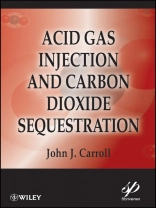Provides a complete treatment on two of the hottest topics in
the energy sector – acid gas injection and carbon dioxide
sequestration
This book provides the most comprehensive and up-to-date
coverage of two techniques that are rapidly increasing in
importance and usage in the natural gas and petroleum industry
— acid gas injection and carbon dioxide sequestration. The
author, a well-known and respected authority on both processes,
presents the theory of the technology, then discusses practical
applications the engineer working in the field can implement.
Both hot-button issues in the industry, these processes will
help companies in the energy industry ‘go green, ‘ by creating a
safer, cleaner environment. These techniques also create a more
efficient and profitable process in the plant, cutting waste and
making operations more streamlined.
This outstanding new reference includes:
* Uses of acid gas injection, the method of choice for disposing
of small quantities of acid gas
* Coverage of technologies for working towards a zero-emission
process in natural gas production
* A practical discussion of carbon dioxide sequestration, an
emerging new topic, often described as one of the possible
solutions for reversing global warming
* Problems and solutions for students at the graduate level and
industry course participants
Tabla de materias
Preface.
Acknowledgement.
Chapter 1 Introduction.
1.1 Acid Gas.
1.2 Anthropogenic C02.
1.3 Flue Gas.
1.4 Standard Volumes.
1.5 Sulfur Equivalent.
1.6 Sweetening Natural Gas.
1.7 Acid Gas Injection.
1.8 Who Uses Acid Gas Injection?
1.9 In Summary.
Chapter 2: Hydrogen Sulfide and Carbon Dioxide.
2.1 Properties of Carbon Dioxide.
2.2 Properties of Hydrogen Sulfide.
2.3 Estimation Techniques for Physical Properties.
2.4 Properties of Acid Gas Mixtures.
2.5 Effect of Hydrocarbons.
2.6 In Summary.
Chapter 3 Non-Aqueous Phase Equilibrium.
3.1 Overview.
3.2 Pressure-Temperature Diagrams.
3.3 Calculation of Phase Equilibrium.
3.4 In Summary.
Chapter 4 Fluid Phase Equilibria Involving Water.
4.1 Water Content of Hydrocarbon Gas.
4.2 Water Content of Acid Gas.
4.3 Estimation Techniques.
4.4 Acid Gas Solubility.
4.5 In Summary.
Chapter 5 Hydrates.
5.1 Introduction to Hydrates.
5.2 Hydrates of Acid Gases.
5.3 Estimation of Hydrate Forming Conditions.
5.4 Mitigation of Hydrate Formation.
5.5 Question!
5.6 Excess Water.
5.7 In Summary.
Chapter 6 Compression
6.1 Overview.
6.2 Theoretical Considerations.
6.3 Compressor Design and Operation.
6.4 Design Calculations.
6.5 Interstage Coolers.
6.6 Compression and Water Knockout.
6.7 Materials of construction
6.8 Advanced design.
6.9 Case studies.
6.10 In Summary.
Chapter 7 Dehydration of Acid Gas.
7.1 Glycol Dehydration.
7.2 Molecular Sieves.
7.3 Refrigeration.
7.4 Case Studies.
7.5 In Summary.
Chapter 8 Pipeline.
8.1 Pressure Drop.
8.2 Temperature Loss.
8.3 Guidelines.
8.4 Metering.
8.5 Other Considerations.
8.6 In Summary.
Chapter 9 Injection Profiles.
Chapter 10 Selection of Disposal Zone.
10.1 Containment.
10.2 Injectivity.
10.3 Interactions With Acid Gas.
10.4 In Summary.
Chapter 11 Health, Safety and The Environment.
11.1 Hydrogen Sulfide.
11.2 Carbon Dioxide.
11.3 Emergency Planning.
Chapter 12 Capital Costs.
12.1 Compression.
12.2 Pipeline.
12.3 Wells.
12.4 In Summary
Chapter 13 Additional Topics.
13.1 Rules of Thumb
13.2 Graphical Summary
13.3 The Three Types of Gas
Index.
Sobre el autor
John J. Carroll, Ph D, PEng is the Director, Geostorage Process Engineering for Gas Liquids Engineering, Ltd. in Calgary, Canada. He joined Gas Liquids Engineering after three years with Honeywell Hi-Spec Solution in London, Canada, and, previous to that, Dr. Carroll was a Research Associate and Lecturer at the University of Alberta in Edmonton, Canada. Dr. Carroll holds bachelor and doctoral degrees in chemical engineering from the University of Alberta, Edmonton, Canada, and is a registered professional engineer in the provinces of Alberta and New Brunswick in Canada. His fist book, Natural Gas Hydrates: A Guide for Engineers, is now in its second edition, and he is the author or co-author of 50 technical publications and about 40 technical presentations.












